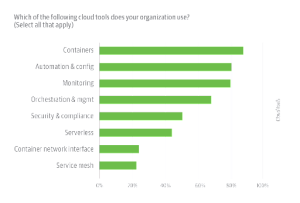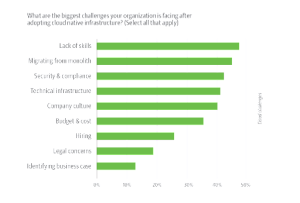Disclaimer: The author is completely responsible for the content of this article. The opinions expressed are their own and do not represent IEEE’s position nor that of the Computer Society nor its Leadership.
 Cloud native architecture gives businesses the power to build and run their scalable applications in the cloud. It is an application architecture built explicitly for the cloud and to make the best use of what cloud computing has to offer. We will examine what makes cloud native architecture so effective and what principles should be adhered to in order to get the most from it.
Cloud native architecture gives businesses the power to build and run their scalable applications in the cloud. It is an application architecture built explicitly for the cloud and to make the best use of what cloud computing has to offer. We will examine what makes cloud native architecture so effective and what principles should be adhered to in order to get the most from it.
Why Use Cloud Native Architecture?
Many of the industries adopting the use of cloud native architecture operate within the software sector, especially early adopters.
Image sourced from Oreilly.com
Using cloud native architecture for development allows software developers to bypass many of the constraints imposed by traditional development on monolithic architecture. It is because cloud native architecture uses a combination of methodologies to build applications that consist of loosely coupled services.
It means that applications built using cloud-native architecture offer a faster time to market, are highly scalable, and are very reliable. So whether you’re developing a unified communications solution or email tracking software, embracing cloud-native architecture is a great place to start.
6 Cloud Native Principles to Know About

Several fundamental principles govern how cloud-native software should be designed. These principles ensure that any software developed in the cloud uses its unique capabilities.
Want More Tech News? Subscribe to ComputingEdge Newsletter Today!
Scalable
Scalability is one of the main advantages of development using cloud native architecture. It eliminates the need to employ fixed hardware or software resources. If you were running your own data center, you would need to ensure you have enough server capacity to cope on your most demanding day. Any time you’re not operating at full capacity, however, you’d be running excess capacity, possibly at a high cost.
With cloud native architecture, you can readily scale the different functional areas of your application as needed. It ensures that you’re never running excess capacity and that you can easily access more resources should demand suddenly jump.
Alternative, non-relational data storage methods, such as Databricks SQL, provide a scalable form of data storage while making it easier for teams to access information. It makes them a popular tool for use in cloud native architecture.

Resilient
Another fundamental principle of cloud-native architecture is that it should be resilient. The more resilient your software, the less time your teams will have to spend trying to fix issues should exceptions of software and hardware components occur. Uncertain inputs and unstable dependencies can cause issues for cloud native software, so precautions must be taken to maintain the ‘always online’ functionality of your service.
Cloud providers can also offer features and tools which can help build resilience. Autoscalers can launch new copies of microservices if one should crash. It helps your system to absorb load rather than shed it in the event of an error.
Part of creating resilience in your cloud native software is limiting the amount of data that flows into it to only what can be efficiently processed by it. Extra tools such as solution accelerators can speed up data processing and help provide a range of industry solutions.
Observable
The observability of your cloud native architecture determines how easily you can see how well the various components of your system are working together. It allows you to understand what each component is doing and more importantly, alerts you when something goes wrong.
Having an observable system means you can detect errors quickly, giving you more chances to resume regular service for your user. It’s also beneficial to be able to observe the API calls to your cloud provider that configure your system. It can allow you to ensure everything is configured properly and even gives you more of a chance to detect any malicious activity.
Automated
Automation is the key to achieving consistency in the cloud environment. Using tools such as microservices, DevOps, containers, and other third-party components increases the complexity of the technology stack and makes software delivery more complex. Standardizing the infrastructure is, therefore, important in achieving automation. It ensures that all applications are performing with the same ultimate goal in mind as the final state is approached.
Automation helps to achieve all the other fundamental principles we’ve mentioned. Systems are more resilient when they can be automatically restarted after a failure. Automated management tools provide an efficient way to read the state of the environment and observe for any errors.
Secure
Cloud native architectures are, by definition, internet-facing services and so are susceptible to external security threats. Security is one of the biggest obstacles for organizations in adopting cloud native infrastructure. Many cloud native architectures, therefore, adopt a defense-in-depth approach to security.

This ensures authentication between components, reducing the opportunities for malicious actors to gain access. Rate limiting and script injection can also help each component protect itself from others in the system. A defense-in-depth approach helps to boost the resilience of the system and makes it easier to deploy in a cloud environment.
Future-Proof
One of the key features of cloud native architecture is that it’s constantly evolving. Very few architecture models are clearly defined from the beginning, and those that are, do not maintain that definition throughout the lifecycle of the software.
Cloud native software needs to be constantly changed and updated to meet the needs of the business it’s serving, as well as the changing demands of its customers. Good architecture planning can help to reduce the costs of introducing new technology and updates further down the line.
Evolutionary architecture is valuable to businesses as software changes can often be hard to predict and expensive to implement. Evolutionary architecture helps to alleviate these concerns, as it focuses design on scalability and loose coupling in the early stages of development.
It simplifies the process of implementing changes later on and reduces the cost of refactoring and upgrading. It also means that these changes can be made at any stage of the software’s lifecycle, from during development, right up until after release.
Get the Most From Cloud Native Architecture
Cloud native architecture is based on the essential components of cloud computing; scalability, resilience, automation, and observability. These principles and business objectives guide software development in the cloud.
Embracing these principles, and working towards fulfilling them, is the key to success with cloud native architecture. Once you do, you’ll secure success as the ecosystem continues to change into the future, whether your goal is to build the best electronic signature software or the next big streaming service.
About the Writer
Pohan Lin is the Senior Web Marketing and Localizations Manager at Databricks, a global Data and AI provider connecting the features of data warehouses and data lakes to create lakehouse architecture. With over 18 years of experience in web marketing, online SaaS business, and ecommerce growth. Pohan is passionate about innovation and is dedicated to communicating the significant impact data has in marketing with the Databricks learning path. Pohan Lin also published articles for domains such as SME-News.
The post Cloud Native Architecture: 6 Cloud Native Principles to Know About first appeared on IEEE Computer Society.

0 Commentaires